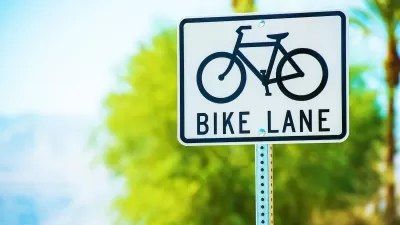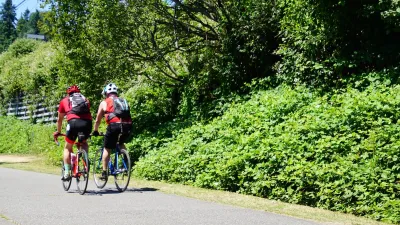Joseph Stromberg provides an explainer post detailing both sides, and the common ground, of the "vehicular cycling" versus "segregated cycling" debate.
Following the approval of a three-foot passing law for bikers in California this week, Joseph Stromberg examines the ongoing debate about the best way for cars and bikes to coexist on streets. For instance, writes Stromberg, some advocates think the befits of such laws are overblown: "These advocates point to a general lack of enforcement of the rules — but they also argue, more broadly, that making slight concessions for cyclists as part of a system designed entirely for cars is no way to make city biking safe and accessible to the casual rider."
"This disagreement is part of a broader disagreement amongst cyclists: whether bikers should simply share the road with cars, obeying all of the same rules (a philosophy commonly called 'vehicular cycling'), or whether cities should be investing in specialized infrastructure so that bikes and cars don't have to mingle (a position often called 'segregated cycling')."
One the side of vehicular cycling, Stromberg makes the follwing point (among many other points) that surprises many non-biker or novice biker members of the public: "…many proponents of vehicular cycling are actually against measures like protected bike lanes and separated trails. One reason, they argue, is that these lanes are more dangerous at intersections than just riding in the road — because cars turning in front of these lanes don't expect bikes to ride through."
On the side of segregated cycling, Stromberg also voices a large number of arguments posed by people who believe vehicular cycling is a vestige of a time when less bike infrastructure existed.
FULL STORY: Should bikes and cars share the same road — and the same rules?

Alabama: Trump Terminates Settlements for Black Communities Harmed By Raw Sewage
Trump deemed the landmark civil rights agreement “illegal DEI and environmental justice policy.”

Planetizen Federal Action Tracker
A weekly monitor of how Trump’s orders and actions are impacting planners and planning in America.

The 120 Year Old Tiny Home Villages That Sheltered San Francisco’s Earthquake Refugees
More than a century ago, San Francisco mobilized to house thousands of residents displaced by the 1906 earthquake. Could their strategy offer a model for the present?

Opinion: California’s SB 79 Would Improve Housing Affordability and Transit Access
A proposed bill would legalize transit-oriented development statewide.

Record Temperatures Prompt Push for Environmental Justice Bills
Nevada legislators are proposing laws that would mandate heat mitigation measures to protect residents from the impacts of extreme heat.

Downtown Pittsburgh Set to Gain 1,300 New Housing Units
Pittsburgh’s office buildings, many of which date back to the early 20th century, are prime candidates for conversion to housing.
Urban Design for Planners 1: Software Tools
This six-course series explores essential urban design concepts using open source software and equips planners with the tools they need to participate fully in the urban design process.
Planning for Universal Design
Learn the tools for implementing Universal Design in planning regulations.
Clanton & Associates, Inc.
Jessamine County Fiscal Court
Institute for Housing and Urban Development Studies (IHS)
City of Grandview
Harvard GSD Executive Education
Toledo-Lucas County Plan Commissions
Salt Lake City
NYU Wagner Graduate School of Public Service





























